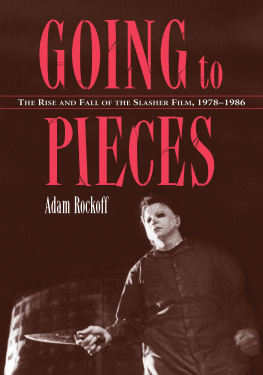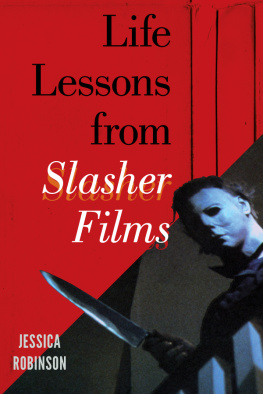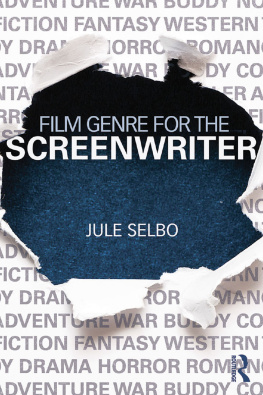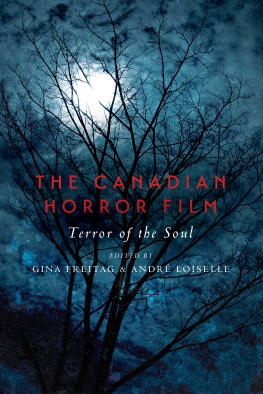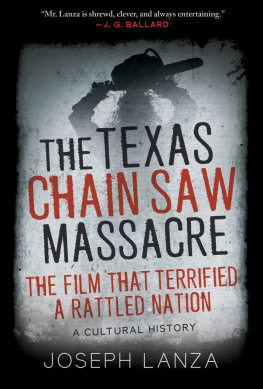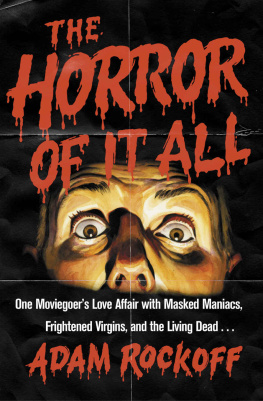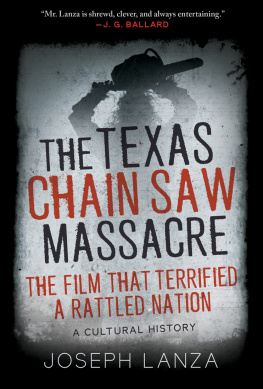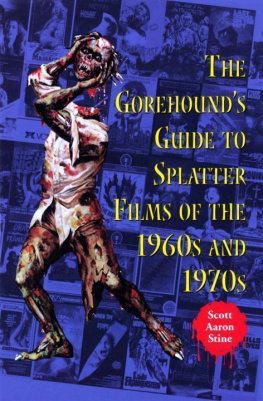
Table of Contents
LIBRARY OF CONGRESS CATALOGUING-IN-PUBLICATION DATA
e-ISBN 978-0-7864- 9192-6
BRITISH LIBRARY CATALOGUING DATA ARE AVAILABLE
2002 Adam Rockoff. All rights reserved
No part of this book may be reproduced or transmitted in any form or by any means, electronic or mechanical, including photocopying or recording, or by any information storage and retrieval system, without permission in writing from the publisher.
Cover photograph: George Wilbur as the title character in Halloween 6: The Curse of Michael Myers (1995).
McFarland & Company, Inc., Publishers
Box 611, Jefferson, North Carolina 28640
www.mcfarlandpub.com
For Lori,
who likes romantic comedies
Acknowledgments
Contrary to popular belief, writing a book is never an individual effort. The prevailing image of a solitary writer hunched over his keyboard, pounding on the keys in a monotonous rhythm, subsisting on copious amounts of coffee, is only part of the story. The reality is that a book relies on the efforts of many individuals. In this case, there are more than a few people to whom I am forever indebted for their time, assistance, support and, most of all, enthusiasm.
First and foremost, I would like to thank the directors, producers and writers of these slasher films who took time out of their busy schedules to speak with me: Ruth Avergon, Danilo Bach, John Carpenter, Sean Cunningham, Tom DeSimone, John Dunning, Herb Freed, Bill Lustig, Paul Lynch, Armand Mastroianni, John McCarty, Jack Sholder, Roger Spottiswoode, Fred Walton, Irwin Yablans and Joe Zito. While their recollections and anecdotes were indispensable to this book, more importantly, I know I speak for horror fans everywhere when I say thank you for your films. They are part of the reason I still check under the bed before going to sleep.
I would also like to thank the various individuals and companies who were kind enough to supply me with the stills from these slasher films: Eric Caidin and Hollywood Book & Poster, Jerry Ohlingers Movie Material Store, Inc., Gene Massimo, Buddy Barnett and Collectors Book Store. The New York Ripper aint Star Wars, and to say that there is a dearth of material on some of the more obscure slashers is a gross understatement. Luckily, these people had the foresight to preserve this memorabilia and were kind enough to share it with me.
Finally, words cannot express how grateful I am to my wife Lori, whose unwavering support throughout the course of this project was instrumental to its completion. For over a year and a half, she fell asleep to the soothing hum of a chainsaw as I stayed up well into the night screening hundreds of slashers. Thats what a good woman will do for you.
Introduction
People are generally intrigued when they find out I am writing a book about film. When I tell them its about horror films, they often raise their eyebrows and shake their head in consternation. When I tell them, somewhat sheepishly, its specifically about slashersthat especially violent breed of films which proliferated in the early 1980sthey quickly gather their children and hurry off in the opposite direction, usually throwing a nervous glance over their shoulder.
If there is something commendable about writing a book on cinema, then there is something less than noble about writing a book on horror films, and something downright perverse about writing a book about slasher movies. These brutal and gory films which came of age during the late 1970s were the bastard children of the horror film, too gleefully violent and graphic to be embraced by the mainstream, but far too popular and successful to achieve true cult status. They hovered somewhere in a cinematic netherworldbetween popular and counterculturetaunting critics who found them indicative of the decline of Western civilization while enthralling millions of dedicated fans who flocked to every new release.
Critics often dismiss the slasher film without acknowledging the indelible mark it left on American culture. To parents, Michael, Jason and Freddy were the allAmerican kids down the block, but to teenagerswhose fear and devotion (not to mention their money) gave these boogeymen lifethey were a new breed of hero. Comic books and trading cards detailed their adventures. Miniature action figures, complete with plastic knives, axes and machetes, filled toy stores where once upon a time Luke Skywalker and Han Solo held court. Nintendo released video games based on both Friday the 13th and A Nightmare on Elm Street. On Halloween, what self-respecting kid would want to be a ballplayer, or even a vampire for that matter, when for only $19.95 he could brandish a plastic replica of Freddys glove? The slasher film hadnt just entered our nightmares, it had entered our national consciousness.
After Im asked what my book is about, if people arent immediately turned off by its subject, the next question is inevitably along the lines of, Why slasher films? Few can comprehend how I can both enjoy and admire these films, and even fewer understand how I could have devoted hundreds of hours to researching, watching and writing about them. They seem baffled that any normal well-adjusted adult could possibly immerse himself in such a disagreeable subject for so long.
Unlike most of the authors who have written on the horror film, I was not weaned on the Universal Classics. I didnt collect EC horror comics or sprint to the corner newsstand each month eagerly awaiting the new issue of Famous Monsters of Filmland. I was far too young to sneak into the now infamous drive-in double feature. Instead, I read Fangoria and Gorezone, viewed horror films mostly in the comfort of my living room, and terrified my babysitting girlfriends with taunts of, Have you checked the children? I was a child of the slasher film.
In the early 1980s, cable television was still in its infancy. Viewers were not yet bombarded with 500 channels, 498 of which they cared little about. In those days, the cable guide was a slim full color pamphlet printed on glossy paper, not the flimsy newsprint booklet of today. The films were listed alphabetically with a short blurb describing each one, followed by any of the four words or phrases used to describe potentially objectionable content: adult themes, nudity, profanity, violence.
I was drawn to the ones which warned of violence. Even their names were terrifying: Halloween, Friday the 13th, He Knows Youre Alone, Terror Train, The Burning, Hell Night. What unspeakable horrors could possibly be contained within a film that had the temerity to call itself My Bloody Valentine? What terrors lurked under such innocuous sounding titles as Prom Night, Graduation Day, Night School and Happy Birthday to Me? Was To All a Goodnight really an uplifting drama about holiday cheer. I didnt think so.
If cable television was theater industrys Scylla, then home video was its Charybdis. Renting a video, making some popcorn and plopping down in the confines of the home was both cheaper and more convenient than trekking to a movie theater. The video store squared off against the multiplex for the eyes and ears of America. Although the traditional movie theater never became obsolete, as the traditionalists predicated, its monopoly on theatrical exhibition was forever shattered.
While the birth of cable television and home video sent shock waves through the industry, for me, and thousands of kids like me, it meant one thingfilms which in a million years our parents would never have allowed us to go see were now readily available. Whats more, since I was the only one in the house who knew how to use the record feature on our VCRnot to mention the only one who knew that such a feature existedI could record
Next page
